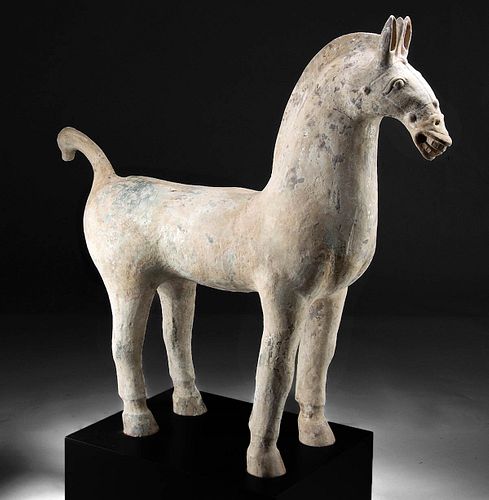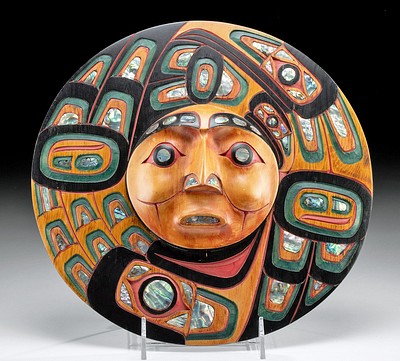Superb / Huge Chinese Han Dynasty Pottery Horse - TL'd
Lot 89a
About Seller
Artemis Fine Arts
686 S Taylor Ave, Ste 106
Louisville, CO 80027
United States
Selling antiquities, ancient and ethnographic art online since 1993, Artemis Gallery specializes in Classical Antiquities (Egyptian, Greek, Roman, Near Eastern), Asian, Pre-Columbian, African / Tribal / Oceanographic art. Our extensive inventory includes pottery, stone, metal, wood, glass and textil...Read more
Categories
Estimate:
$15,000 - $20,000
Absentee vs Live bid
Two ways to bid:
- Leave a max absentee bid and the platform will bid on your behalf up to your maximum bid during the live auction.
- Bid live during the auction and your bids will be submitted real-time to the auctioneer.
Bid Increments
| Price | Bid Increment |
|---|---|
| $0 | $25 |
| $300 | $50 |
| $1,000 | $100 |
| $2,000 | $250 |
| $5,000 | $500 |
| $10,000 | $1,000 |
| $20,000 | $2,500 |
| $50,000 | $5,000 |
| $100,000 | $10,000 |
| $200,000 | $20,000 |
About Auction
By Artemis Fine Arts
Dec 7, 2023
Set Reminder
2023-12-07 10:00:00
2023-12-07 10:00:00
America/New_York
Bidsquare
Bidsquare : Fine Antiquities, Ancient & Pre-Columbian Art
https://www.bidsquare.com/auctions/artemis-gallery/fine-antiquities-ancient-pre-columbian-art-14361
Classical antiquities, ancient, and ethnographic art from cultures encompassing the globe. Egyptian, Greek, Roman, Etruscan, Near Eastern, Asian, Pre-Columbian, Native American, African / Tribal, Oceanic, Spanish Colonial, Fine / Visual Arts, so much more! Artemis Fine Arts info@artemisgallery.com
Classical antiquities, ancient, and ethnographic art from cultures encompassing the globe. Egyptian, Greek, Roman, Etruscan, Near Eastern, Asian, Pre-Columbian, Native American, African / Tribal, Oceanic, Spanish Colonial, Fine / Visual Arts, so much more! Artemis Fine Arts info@artemisgallery.com
- Lot Description
**This item is heavy/oversized and will require 3rd party shipping. Please inquire about shipping cost prior to bidding.**
China, Han Dynasty, ca. 206 BCE to 220 CE. Massive and amazing terracotta horse that is very reminiscent of the pottery tomb figures so famous from this era. Heavy molded horse with stoic stance, muscular body, alert ears and long curled tail. Incredibly this was once entirely covered in that deep green glaze, remains found allover but especially on the horse's haunches. That green glaze has now transformed into a rainbow of iridescence. Size: 42" L x 43" W (106.7 cm x 109.2 cm); 51" H (129.5 cm) on included custom stand.
The Han Dynasty was a period of wealth and stability for China, and the burial places of their rulers reflected this prosperity; they held hundreds and sometimes thousands of miniature terracotta figures who reflected the daily life of the Emperor's court, including warriors clad in full armor, servants, eunuchs, animals, and models of important buildings like granaries. The creation of all these pottery figures spawned a huge industry and the remains of workshops have been found near some of the burial mounds. Even though they were produced en masse, mingqi often exhibit a high level of detail and naturalism, as seen here.
This horse has been tested using Thermoluminesce (TL) methodology in 3 different locations and results show an estimated age of 2000 years. Report will accompany this piece.
Provenance: private Constance McCormick Fearing estate, Montecito, California, USA, acquired before 2004. Ms. Fearing was from the McCormick Harvester International family and owned an amazing 18 acre estate in Montecito, California.
All items legal to buy/sell under U.S. Statute covering cultural patrimony Code 2600, CHAPTER 14, and are guaranteed to be as described or your money back.
A Certificate of Authenticity will accompany all winning bids.
We ship worldwide and handle all shipping in-house for your convenience.
#180976Repairs to legs as is almost always the case, surface wear and loss to original green pigment, but a magnificent example! On side of horse a smallish swastika has been carved, but based on deposits on and around this area we believe this to be from antiquity and meant as a sign of good luck or well wishes - a practice common throughout the ancient world.Condition
- Shipping Info
-
All shipping is handled in-house for your convenience. Your invoice from Artemis Gallery will include shipping calculation instructions. If in doubt, please inquire BEFORE bidding for estimated shipping costs for individual items.
-
- Buyer's Premium



 EUR
EUR CAD
CAD AUD
AUD GBP
GBP MXN
MXN HKD
HKD CNY
CNY MYR
MYR SEK
SEK SGD
SGD CHF
CHF THB
THB














